Seoul, the dynamic capital of South Korea, is a vibrant city that effortlessly showcases its futuristic skyscrapers and bustling city streets alongside its traditional palaces and fortress walls.
Though it's cosmopolitan, it's a city that seamlessly weaves its historic sites, some of which date back to the early Joseon Dynasty of the 14th century, with incredibly modern, hip neighborhoods with the trendiest shopping streets. It's a blend of both tradition and modernity, and perhaps this can best be seen in its varying culinary scene and overall food culture.
You can't eat your way through Seoul without venturing through the busy, chaotic street markets that include Gwangjang Market and Namdaemun Market.
If you're looking to immerse yourself in the culinary landscape of the city, come to a market hungry, and feast on a variety of mandu (dumplings), bindae-tteok (mung bean pancake), kal-guksu (knife-cut noodle soup), tteokbokki (spicy rice cakes) and more.
Korean cuisine offers an array of complex flavors and textures, and along with the utilization of cooking and fermentation and pickling techniques, is known for delicious dishes like bulgogi (thinly sliced beef barbecue), japchae (stir-fried glass noodles), kimchi jjigae (spicy kimchi stew) and countless other flavor-packed dishes.
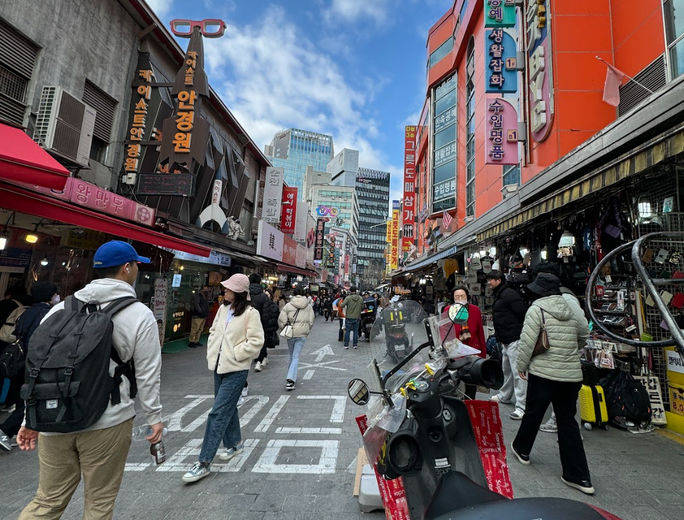
Namdaemun Market. (Photo Credit: Chelsea Davis)
The foundation of it all? Jang, or fermented pastes, is made from soybeans. The most important Korean foods are fermented and include gochujang (red chili paste) and sikhae (salted and fermented fish).
I came to Seoul specifically for Asia's 50 Best Restaurant Awards and was fully expecting to be blown away by the selection of multi-course restaurant collaboration meals that the awards ceremony hosted for its guests.
We experienced three restaurant collaboration events which included New Wave of Seoul Chef's Feast featuring six curated offerings by restaurants Legume, Level:0, y'east, Vinho, Mater and Restaurant Juen and a 12-course dinner experience that centered on the themes of "tradition" and the "art of simple and delicate flavors" by restaurants Onjium in Seoul, The Chairman in Hong Kong and Seroja in Singapore.
The most epic dinner, however, was the 17-course gala dinner at Mingles — Asia's 13th best restaurant this year — by Seoul restaurants Kang Minchul, Muoki, Evett, L'Impression, Zero Complex and Mingles.
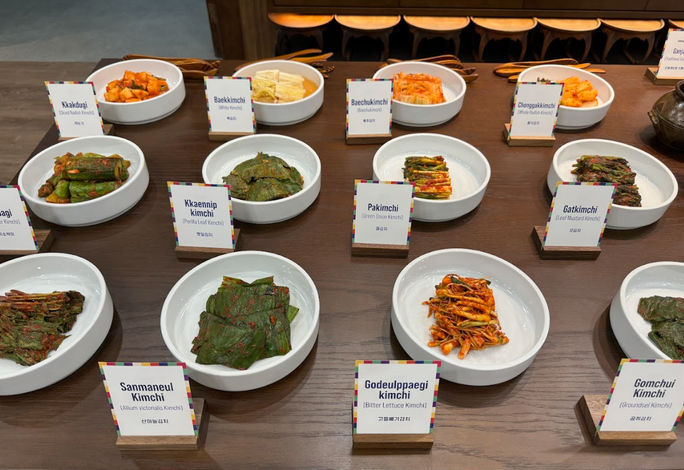
Kimchi selection. (Photo Credit: Chelsea Davis)
What I wasn't expecting was to be so fascinated by the culture and history that I learned during three hansik workshops. For reference, hansik essentially means Korean food or cuisine and according to the Korean Food Promotion Act, hansik translates to food made with Korean ingredients, using Korea's traditional cooking methods and recipes, as well as activities related to that food.
I experienced three classes hosted by the Ministry of Agriculture, Food and Rural Affairs, Seoul Metropolitan Government and the Korean Food Promotion Institute. They were Temple Food: Vegetarian Cuisine of Korea, Korean Meat: K-BBQ and Kimchi, Jang and Traditional Liquor: Fermentation of Hansik.
Each topic is one of the key pillars of Korean cuisine. These culinary workshops expertly showcased the deep-rooted culinary heritage of Korea, with tutelage by leaders in the respective topics.
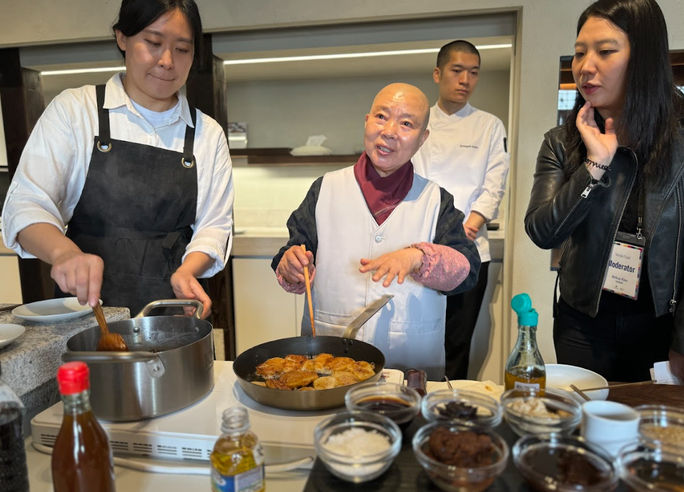
Jeong Kwan. (Photo Credit: Chelsea Davis)
The temple food workshop was led by the iconic monk chef, Jeong Kwan Seunim, who has received international recognition as the recipient of the Icon Award from Asia's 50 Best Restaurants 2022 for her contributions to the restaurant industry.
You may also recognize Kwan from Netflix's Chef Table, in which she raised global awareness of Korea's temple food, bringing it to the attention of some of the culinary world's elites, including three-Michelin-star chef and Le Bernardin owner, Eric Ripert.
During her workshop, she cheerfully cooked us a lunch of Yeonnipbap (lotus leaf rice), pyogobeoseot jocheongjorim (shiitake mushrooms glazed in soy sauce and grain syrup), doenjang mujeon (soybean paste and radish pancakes), baechukimchi (cabbage kimchi) and yakgwa (honey cookies), ssalgangjeong (sweet rice puffs) and fermented tea.
While cooking, she went into detail about not only her cooking philosophy but also her Buddhist practice, both of which go hand in hand. Temple food, specifically the primarily vegan cuisine that monks are allowed to eat, is a means of practicing Buddhist doctrine. In Korean culture, food and medicine "are born from the same root."
According to Kwan, the key to cooking is being able to connect with your ingredients and only then can you understand the best ways to prepare them. Moreover, if you don't connect with your food, you won't be able to absorb its nutrients. After lunch, we enjoyed a session of meditation, and I can safely say I left with a renewed outlook on eating.
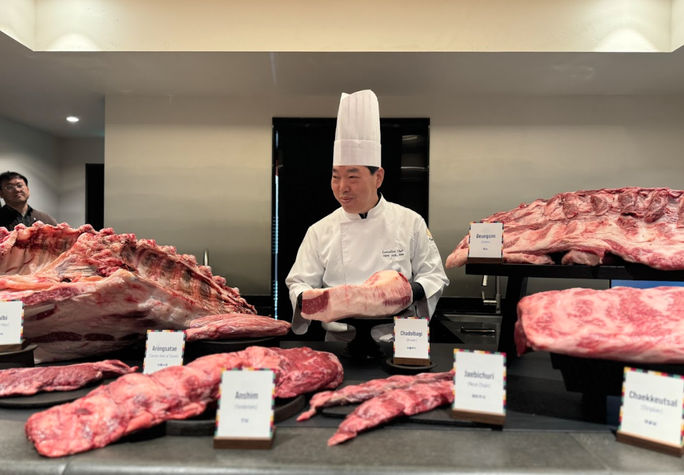
Korean BBQ. (Photo Credit: Chelsea Davis)
Our next workshop focused on Korea's famous barbecue and hanu (Korean beef). It took place at Byeok-Je Galbi, one of the top Korean barbecue restaurants in Seoul where the meat is cut and grilled tableside.
Led by Yoon Wonsuk, a "meat master" and executive chef with over 40 years of experience, we discussed everything from meat aging and how to butcher a full cow to a full explanation of the best cuts of meat to order, grilling plates and more, ending with a grilling demonstration and taste test of various cuts of meat.
During our lunch, we were introduced to the various side dishes that accompany a traditional Korean barbecue meal such as jangaji (pickled vegetables), gatkimchi (leaf mustard kimchi), other seasoned vegetables and sauces like ssamjang (red chili and soybean paste).
Korean beef, as called hanu, is known for having anywhere from 10 cuts to 39 cuts of meat, depending on the butcher. From the sirloin to rump to shank and chuck, we got to taste the juicy cuts while the chefs grilled the meat table side.
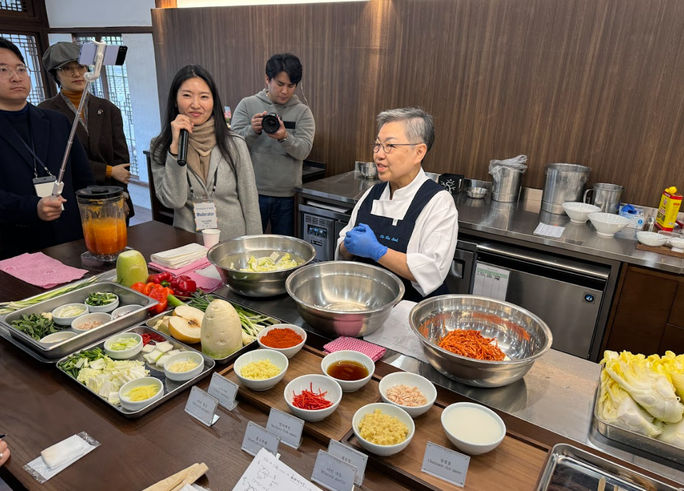
Fermentation class. (Photo Credit: Chelsea Davis)
Our last workshop was all about fermentation, a staple of Korean cuisine, led by Chef Cho Heesok, cooking advisor for Korea House and non-executive director of the Korean Food Promotion Institute. She also is known as the "godmother of Korean food" based on four decades of professional cooking experience and was named Asia's Best Female Chef in 2020.
As mentioned earlier, Jang is the foundation of Korean food, and as such this class focused on how it's made. It's the outcome of a complex fermentation that involves microorganisms. Soybean blocks, or "meju", are first dried and then left to ferment for 40-60 days inside an earthenware filled with salt and water. The meju is eventually taken out, crushed and packed into another jar, before being fermented one more time with soy sauce and water.
In addition to learning how jang is created, we learned how to make kimchi, Korea's most widely recognized food, and how traditional Korean liquor is made through the use of nuruk, a fermentation starter. After the workshop we enjoyed a meal of fermented foods, seasoned with different types of jang, and paired with Korean liquor.
Between these three hansik workshops, experiencing several markets and dining at some of the most esteemed restaurants in Seoul, this short trip to Korea gave me immense insight into the culinary scene of Seoul and I can't wait to come back.
For the latest travel news, updates and deals, subscribe to the daily TravelPulse newsletter.
Topics From This Article to Explore